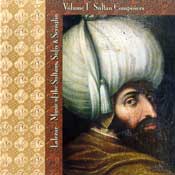|
Lalezar Ensemble
Music Of the Sultans, Sufis & Seraglio (Vol. I and Vol. II)
Traditional Crossroads (www.traditionalcrossroads.com)
 The revival of Ottoman Art music in Turkish society is an interesting phenomenon on a number of levels. Between the 16-19th centuries during the height of the Ottoman Empire, an elite, urban, supra-national musical traditional flourished. Unlike the folk and religious music forms practiced by the many religious and ethnic communities that were part of the empire, Ottoman Art Music was a self-conscious form that saw itself as above all the local, ethnic and religious musical conventions. Ottoman art music assimilated countless outside influences. But it also invented a series of distinct styles and set up numerous new traditions. Supported by an urban elite, Ottoman art music was never embraced by most rural Turks or by the non-Turkish communities. However, if one was a talented Greek, Armenian, Jewish, Gypsy or Turkish musician who aspired to make it to the big time, you headed for city-especially Constantinople-to the Ottoman court in order to secure patronage.
The revival of Ottoman Art music in Turkish society is an interesting phenomenon on a number of levels. Between the 16-19th centuries during the height of the Ottoman Empire, an elite, urban, supra-national musical traditional flourished. Unlike the folk and religious music forms practiced by the many religious and ethnic communities that were part of the empire, Ottoman Art Music was a self-conscious form that saw itself as above all the local, ethnic and religious musical conventions. Ottoman art music assimilated countless outside influences. But it also invented a series of distinct styles and set up numerous new traditions. Supported by an urban elite, Ottoman art music was never embraced by most rural Turks or by the non-Turkish communities. However, if one was a talented Greek, Armenian, Jewish, Gypsy or Turkish musician who aspired to make it to the big time, you headed for city-especially Constantinople-to the Ottoman court in order to secure patronage.
Even prior to the collapse of the Ottoman Empire, this art music was in decline as court military and economic power declined. During the first 50 years of the modern Turkish state, this huge rich repertoire fell into almost total non-use. It's only been since the 1970s that a group of Turkish and foreign musicians and musicologists have begun to revive this tradition.
The Istanbul-based Lalezar Ensemble comes at this tradition through the study of early manuscripts and old recordings from the last Ottoman-era musicians. On these first two volumes of a projected four volume series, the Lalezar Ensemble performs several styles of 19th century Ottoman music. Volume one, "Sultan Composers," includes examples of beste and sarki music. These forms have very specific principles that follow rhythmic cycles (usuls) broken up by taksims, non-metrical improvisations that highlighted a composer's special talents. Volume two, "Music Of the Dancing Boys," explores the cengi/kocek tradition. These are a series of dance suites, which have a rhythmic similarity to Greek, and Balkan folk dance music. The musicianship is first class as might be expected from this elite group of conservatory-trained musicians.
Both CDs contain copious notes written by Walter Feldman, an American Balkan musicologist and noted klezmer musician. These releases, particularly Volume II, are immediately accessible to anyone with an interest in or familiarity with Arabic or Persian music. - Aaron Howard
Read about Volumes III and IV
Audio ©2000 Traditional Crossroads
Comment on this music or the web site.
Write a Letter to the Editor
|

